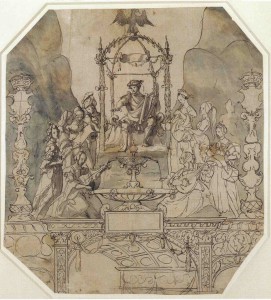
At 5pm on the 31st, Anne left the Tower confines to begin her procession through the streets of London to Westminster Hall. Edward Hall describes how the streets were gravelled and railed off, so that people would not get hurt. Cornhill and Gracehurch Street were decorated with scarlet and crimson cloth, arras, tapestries and carpets, while Cheapside was decorated with “cloth of tissue, gold, velvet and many rich hangings”.
The mayor was clothed in crimson velvet and escorted by footmen dressed in white and red damask, and the Queen’s part of the procession was led by the servants of Jean de Dinteville, the French ambassador, who were dressed in blue velvet coats with sleeves of blue and yellow velvet. Their horses were “trapped with close trappers of blue sarcenet powdered with white crosses”. After them came “gentlemen, squires and knights”, followed by the judges, and the Knights of the Bath, dressed in ermine trimmed violet gowns and hoods. Next were abbots, barons, bishops, earls, marquesses, the Lord Chancellor, the Archbishop of York, the Venetian ambassador, the Archbishop of Canterbury, the French ambassador, the Mayor of London, William Howard (acting as deputy earl marshal for his brother, Thomas Howard, Duke of Norfolk) and Charles Brandon, Duke of Suffolk, acting as Constable of England.
Behind her chancellor, “sergeants and officers of arms”, came Queen Anne Boleyn in a litter decorated with white cloth of gold and led by two palfreys clad in white damask. Hall describes Anne as wearing a surcoat of white cloth of gold, a mantle of the same cloth, but trimmed with ermine, and a coif with a circlet of “rich stones”. Her hair was loose and flowing. Above her was a canopy of cloth of gold, decorated with gilt statues and silver bells, and carried by the barons of the Cinque Ports. Following the Queen were her chamberlain, Lord Borough, and her master of the horses, William Coffin, then her ladies clothed in crimson velvet and cloth of gold and tissue. Then came chariots carrying the Dowager Duchess of Norfolk and the Marchioness of Dorset (or possibly Elizabeth Boleyn, Anne’s mother), and other ladies of the court.
The procession did not simply process to Westminster, it stopped at points on the route to enjoy various pageants and displays. One pageant was that of Apollo and the nine muses on Mount Parnassus, on the corner of Gracechurch Street. This “ryght costly” pageant had been designed by Holbein. Another pageant, at Leadenhall, was of Anne’s falcon badge. It had a castle with a green, and a “root”, or stump, out of which white and red roses spilled. A white falcon descended from Heaven and landed on the stump, then an angel wearing armour descended and crowned the falcon. Yet another pageant consisted of St Anne, surrounded by her children, the three Marys, and their children. Here, poetry was read to Queen Anne Boleyn, poetry which emphasised England’s hope for her and the child she was carrying. Other pageants included a recreation of the Judgement of Paris, angels holding out crowns to Anne with a lady prophesying that “Quene Anne whan you shalte beare a newe sone of y e kynges bloode there shalbe a golden worlde unto thy people.” Other displays included fountain running with wine, children reading poems of praise for Anne and the King, the Virtues promising to never abandon the Queen and children singing.
Finally, Anne reached Westminster Hall, which was described by Hall as newly glazed and decorated with “cloth of arras”. There, Anne enjoyed refreshments such as “spice plates”, hippocras and wine, which she shared with her ladies. She then gave thanks to lords, ladies and Mayor, and retired for the night. Both Hall and “The noble tryumphaunt coronacyon of Quene Anne, wyfe unto the most noble kynge Henry VIII” pamphlet record that Anne was then taken secretly to spend the night with the King at his “Manor of Westminster”.
Also on this day in 1533…
King Henry VIII dubbed 63 Knights Bachelor. These Knights included Thomas Cromwell and proteges of William Brereton and Henry Norris.
Notes and Sources
- “The noble tryumphaunt coronacyon of Quene Anne, wyfe unto the most noble kynge Henry VIII”, printed by Wynkyn de Worde in 1533. This can be read online at http://archive.org/stream/maneroftryumpheo00goldiala#page/18/mode/2up
- Hall’s Chronicle, Edward Hall, p800-802
- LP vi. 563
- The Life and Death of Anne Boleyn, Eric Ives, p172-174
Also on this day in history…
- 1443 – Birth of Lady Margaret Beaufort, Countess of Richmond and Derby, and matriarch of the Tudor dynasty, at Bletsoe Castle in Bedfordshire. Margaret was the daughter of Margaret Beauchamp of Bletsoe and John Beaufort, 1st Duke of Somerset, grandson of John of Gaunt, 1st Duke of Lancaster, and his mistress (and eventual wife) Katherine Swynford. Find out more about Margaret in my article Lady Margaret Beaufort.
- 1529 – Opening of the Legatine Court at Blackfriars, presided over by Cardinal Campeggio. See Cardinal Campeggio and the Legatine Court.